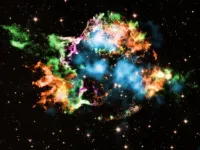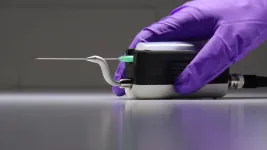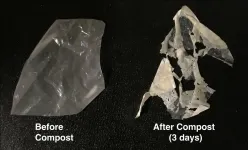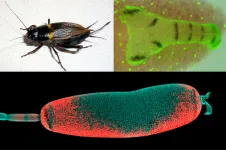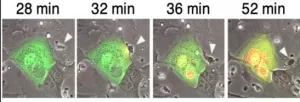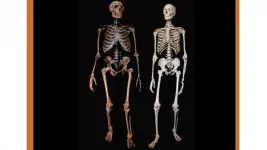(Press-News.org) Scientists have found fragments of titanium blasting out of a famous supernova. This discovery, made with NASA's Chandra X-ray Observatory, could be a major step in pinpointing exactly how some giant stars explode.
This work is based on Chandra observations of the remains of a supernova called Cassiopeia A (Cas A), located in our galaxy about 11,000 light-years from Earth. This is one of the youngest known supernova remnants, with an age of about 350 years.
For years, scientists have struggled to understand how massive stars - those with masses over about 10 times that of the Sun - explode when they run out of fuel. This result provides an invaluable new clue.
"Scientists think most of the titanium that is used in our daily lives -- such as in electronics or jewelry -- is produced in a massive star's explosion," said Toshiki Sato of Rikkyo University in Japan, who led the study that appears in the journal Nature. "However, until now scientists have never been able to capture the moment just after stable titanium is made."
When the nuclear power source of a massive star runs out, the center collapses under gravity and forms either a dense stellar core called a neutron star or, less often, a black hole. When a neutron star is created, the inside of the collapsing massive star bounces off the surface of the stellar core, reversing the implosion.
The heat from this cataclysmic event produces a shock wave - similar to a sonic boom from a supersonic jet - that races outwards through the rest of the doomed star, producing new elements by nuclear reactions as it goes. However, in many computer models of this process, energy is quickly lost and the shock wave's journey outwards stalls, preventing the supernova explosion.
Recent three-dimensional computer simulations suggest that neutrinos -- very low-mass subatomic particles -- made in the creation of the neutron star play a crucial role in driving bubbles that speed away from the neutron star. These bubbles continue driving the shock wave forward to trigger the supernova explosion.
With the new study of Cas A, the team discovered powerful evidence for such a neutrino-driven explosion. In the Chandra data they found that finger-shaped structures pointing away from the explosion site contain titanium and chromium, coinciding with iron debris previously detected with Chandra. The conditions required for the creation of these elements in nuclear reactions, such as the temperature and density, match those of bubbles in simulations that drive the explosions.
The titanium that was found by Chandra in Cas A and that is predicted by these simulations is a stable isotope of the element, meaning that the number of neutrons its atoms contain implies that it does not change by radioactivity into a different, lighter element. Previously astronomers had used NASA's NuSTAR telescope to discover an unstable isotope of titanium in different locations in Cas A. Every 60 years about half of this titanium isotope transforms into scandium and then calcium.
"We have never seen this signature of titanium bubbles in a supernova remnant before, a result that was only possible with Chandra's incredibly sharp images," said co-author Keiichi Maeda of Kyoto University in Japan. "Our result is an important step in solving the problem of how these stars explode as supernovae."
"When the supernova happened, titanium fragments were produced deep inside the massive star. The fragments penetrated the surface of the massive star, forming the rim of the supernova remnant Cas A," said co-author Shigehiro Nagataki of the RIKEN Cluster for Pioneering Research in Japan.
These results strongly support the idea of a neutrino-driven explosion to explain at least some supernovae.
"Our research could be the most important observational result probing the role of neutrinos in exploding massive stars since the detection of neutrinos from Supernova 1987A," said co-author Takashi Yoshida of Kyoto University in Japan.
Astronomers used over a million and half seconds, or over 18 days, of Chandra observing time from Cas A taken between 2000 and 2018. The amount of stable titanium produced in Cas A exceeds the total mass of the Earth.
These results have been published in the April 22, 2021 issue of Nature. In addition to Sato, Maeda, Nagataki and Yoshida, the authors of the paper are Brian Grefenstette (California Institute of Technology in Pasadena, California), Brian J. Williams (NASA Goddard Space Flight Center in Greenbelt, Maryland), Hideyuki Umeda (University of Tokyo in Japan), Masaomi Ono (RIKEN Cluster for Pioneering Research in Japan), and Jack Hughes (Rutgers University in Piscataway, New Jersey).
NASA's Marshall Space Flight Center manages the Chandra program. The Smithsonian Astrophysical Observatory's Chandra X-ray Center controls science from Cambridge Massachusetts and flight operations from Burlington, Massachusetts.
INFORMATION:
The diagnosis of diseases like cancer almost always needs a biopsy - a procedure where a clinician removes a piece of suspect tissue from the body to examine it, typically under a microscope. Many areas of diagnostic medicine, especially cancer management, have seen huge advances in technology, with genetic sequencing, molecular biology and artificial intelligence all rapidly increasing doctors' ability to work out what's wrong with a patient. However the technology of medical needles hasn't changed dramatically in 150 years, and - in the context of cancer management - needles are struggling to provide adequate tissue samples for new diagnostic techniques. Now researchers have shown that modifying the biopsy needle to vibrate rapidly ...
PHILADELPHIA--Piperlongumine, a chemical compound found in the Indian Long Pepper plant (Piper longum), is known to kill cancerous cells in many tumor types, including brain tumors. Now an international team including researchers from the Perelman School of Medicine at the University of Pennsylvania has illuminated one way in which the piperlongumine works in animal models -- and has confirmed its strong activity against glioblastoma, one of the least treatable types of brain cancer.
The researchers, whose findings were published this month in END ...
Scientists have spotted the largest flare ever recorded from the sun's nearest neighbor, the star Proxima Centauri.
The research, which appears today in The Astrophysical Journal Letters, was led by the University of Colorado Boulder and could help to shape the hunt for life beyond Earth's solar system.
CU Boulder astrophysicist Meredith MacGregor explained that Proxima Centauri is a small but mighty star. It sits just four light-years or more than 20 trillion miles from our own sun and hosts at least two planets, one of which may look something like ...
RESEARCH TRIANGLE PARK, N.C. -- With Army funding, scientists invented a way to make compostable plastics break down within a few weeks with just heat and water. This advance will potentially solve waste management challenges at forward operating bases and offer additional technological advances for American Soldiers.
The new process, developed by researchers at University of California, Berkeley and the University of Massachusetts Amherst, involves embedding polyester-eating enzymes in the plastic as it's made.
When exposed to heat and water, an enzyme shrugs off its polymer shroud and starts chomping the plastic polymer into its building blocks -- in the case of biodegradable plastics, which are made primarily of the polyester known as polylactic acid, or PLA, ...
Women at high risk of breast cancer face cost-associated barriers to care even when they have health insurance, a new study has found.
The findings suggest the need for more transparency in pricing of health care and policies to eliminate financial obstacles to catching cancer early.
The study led by researchers at The Ohio State University included in-depth interviews with 50 women - 30 white, 20 Black - deemed at high risk of breast cancer based on family history and other factors. It appears in the Journal of Genetic Counseling.
The researchers considered it a given that women without any insurance would face serious barriers to preventive care including genetic counseling and testing, prophylactic mastectomy and ...
OAK BROOK, Ill. - An artificial intelligence-driven system that automatically combs through brain MRIs for abnormalities could speed care to those who need it most, according to a study published in Radiology: Artificial Intelligence.
MRI produces detailed images of the brain that help radiologists diagnose various diseases and damage from events like a stroke or head injury. Its increasing use has led to an image overload that presents an urgent need for improved radiologic workflow. Automatic identification of abnormal findings in medical images offers a potential solution, enabling improved patient care and accelerated patient discharge.
"There are an increasing number of MRIs that are performed, ...
Certain signalling proteins, which are responsible for the development of innate immune function in almost all animals are also required for the formation of the dorsal-ventral (back-belly) axis in insect embryos. A new study by researchers from the University of Cologne's Institute of Zoology suggests that the relevance of these signalling proteins for insect axis formation has increased independently several times during evolution. For example, the research team found similar evolutionary patterns in the Mediterranean field cricket as in the fruit fly Drosophila, although the two insects are only very distantly related and previous observations suggested different evolutionary ...
Metaplasia is defined as the replacement of a fully differentiated cell type by another. There are several classical examples of metaplasia, one of the most frequent is called Barrett's oesophagus. Barrett's oesophagus is characterized by the replacement of the keratinocytes by columnar cells in the lower oesophagus upon chronic acid reflux. This metaplasia is considered a precancerous lesion that increases by around 50 times the risk of this oesophageal adenocarcinoma. Nonetheless, the mechanisms involved in the development of metaplasia in the oesophagus are still partially unknown.
In a new study published in Cell Stem Cell, researchers led by Mr. Benjamin Beck, ...
Drawing on epidemiological field studies and the FrenchCOVID hospital cohort coordinated by Inserm, teams from the Institut Pasteur, the CNRS and the Vaccine Research Institute (VRI, Inserm/University Paris-Est Créteil) studied the antibodies induced in individuals with asymptomatic or symptomatic SARS-CoV-2 infection. The scientists demonstrated that infection induces polyfunctional antibodies. Beyond neutralization, these antibodies can activate NK (natural killer) cells or the complement system, leading to the destruction of infected cells. Antibody levels are slightly lower in asymptomatic ...
Creativity--the "secret weapon" of Homo sapiens--constituted a major advantage over Neanderthals and played an important role in the survival of the human species. This is the finding of an international team of scientists, led by the University of Granada (UGR), which has identified for the first time a series of 267 genes linked to creativity that differentiate Homo sapiens from Neanderthals.
This important scientific finding, published today in the prestigious journal Molecular Psychiatry (Nature), suggests that it was these genetic differences linked to creativity that enabled Homo sapiens to eventually replace Neanderthals. It was creativity that gave Homo sapiens the ...
